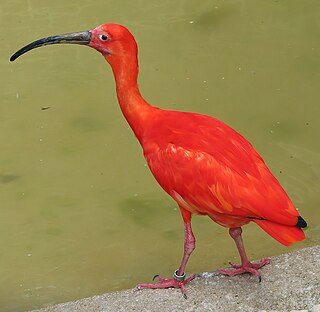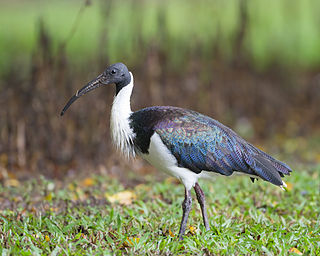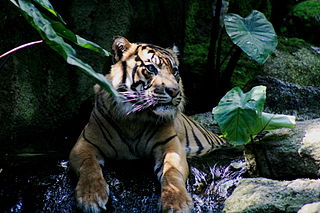
The family Threskiornithidae includes 34 species of large wading birds. The family has been traditionally classified into two subfamilies, the ibises and the spoonbills; however recent genetic studies are casting doubt on the arrangement, and revealing the spoonbills to be nested within the old world ibises, and the new world ibises as an early offshoot.

The Australian pelican is a large waterbird in the family Pelecanidae, widespread on the inland and coastal waters of Australia and New Guinea, also in Fiji, parts of Indonesia and as a vagrant in New Zealand. It is a predominantly white bird with black wings and a pink bill. It has been recorded as having the longest bill of any living bird. It mainly eats fish, but will also consume birds and scavenge for scraps if the opportunity arises.
White ibis may refer to several birds:

The Australian white ibis is a wading bird of the ibis family, Threskiornithidae. It is widespread across much of Australia. It has a predominantly white plumage with a bare, black head, long downcurved bill and black legs. While it is closely related to the African sacred ibis, the Australian white ibis is a native Australian bird - contrary to urban myth, it is not a feral species introduced to Australia by people, and it does not come from Egypt.

The little pied cormorant, little shag or kawaupaka is a common Australasian waterbird, found around the coasts, islands, estuaries, and inland waters of Australia, New Guinea, New Zealand, Thailand, Myanmar, Singapore, Brunei, Timor Leste, and Indonesia, and around the islands of the south-western Pacific and the subantarctic. It is a small short-billed cormorant usually black above and white below with a yellow bill and small crest, although a mostly black white-throated form predominates in New Zealand. Three subspecies are recognised. Until recently most authorities referred to this species as Phalacrocorax melanoleucos.

The Réunion ibis or Réunion sacred ibis is an extinct species of ibis that was endemic to the volcanic island of Réunion in the Indian Ocean. The first subfossil remains were found in 1974, and the ibis was first scientifically described in 1987. Its closest relatives are the Malagasy sacred ibis, the African sacred ibis, and the straw-necked ibis. Travellers' accounts from the 17th and 18th centuries described a white bird on Réunion that flew with difficulty and preferred solitude, which was subsequently referred to as the "Réunion solitaire".

The black-headed ibis, also known as the Oriental white ibis, Indian white ibis, and black-necked ibis, is a species of wading bird of the ibis family Threskiornithidae which breeds in the South- and Southeast Asia from India to the west and as far east as Japan. It is the only native ibis species in its range that has an overall white plumage with a black neck and head. The down-curved beak and legs are also black. Though often referred to as a wetland species, the black-headed ibis forages in a range of natural and man-made habitats. This species of ibis nests only during the rainy season.

The African sacred ibis is a species of ibis, a wading bird of the family Threskiornithidae. It is native to Africa and the Middle East. It is especially known for its role in the religion of the Ancient Egyptians, where it was linked to the god Thoth; despite this, the species is currently extirpated from Egypt.

Rennell Island, locally known as Mugaba, is the main island of two inhabited islands that make up the Rennell and Bellona Province in the Solomon Islands. Rennell Island has a land area of 660 square kilometres (250 sq mi) that is about 80 kilometres (50 mi) long and 14 kilometres (8.7 mi) wide. It is the second largest raised coral atoll in the world with the largest lake in the insular Pacific, Lake Tegano, a lake that is listed as a World Heritage Site. Rennell Island has a population of about 1,840 persons of Polynesian descent who primarily speak Rennellese, Pijin and some English. Rennell and Bellona Islands are two of the few islands in the Melanesian Solomon Island archipelago classified as a Polynesian outlier; others being Sikaiana, Ontong Java, Tikopia, Anuta, Duff Islands, and some Reef Islands.

Threskiornis is a genus of ibises, wading birds of the family Threskiornithidae. They occur in the warmer parts of the Old World in southern Asia, Australasia and Sub-Saharan Africa. They are colonial breeders, which build a stick nest in a tree or bush and lay two to four eggs. They occur in marshy wetlands and feed on various fish, frogs, crustaceans and insects.

The straw-necked ibis is a bird of the ibis and spoonbill family Threskiornithidae. It can be found throughout Australia, New Guinea, and parts of Indonesia. Adults have distinctive straw-like feathers on their necks.

The fauna of Indonesia is characterised by high levels of biodiversity and endemicity due to its distribution over a vast tropical archipelago. Indonesia divides into two ecological regions; western Indonesia which is more influenced by Asian fauna, and the east which is more influenced by Australasian species.

Blyth's hornbill, also known as the Papuan hornbill, is a large hornbill inhabiting the forest canopy in Wallacea and Melanesia. Its local name in Tok Pisin is kokomo.

The Malagasy sacred ibis is a relatively large, heavily built ibis endemic to the west coast of Madagascar, and Aldabra on the Seychelles.

The white-bellied cuckooshrike is a species of bird in the family Campephagidae. It is found in Australia, the Moluccas, New Guinea and the Solomon Islands. Its natural habitats are subtropical or tropical moist lowland forest, subtropical or tropical mangrove forest, and subtropical or tropical moist montane forest.

Vedanthangal Bird Sanctuary is a 30-hectare (74-acre) protected area located in the Chengalpattu District and Madurantakam taluk of the state of Tamil Nadu, India. The sanctuary is about 75 kilometres (47 mi) from Chennai on National Highway 45 ([NH45]). Easily reachable from Madurantakam and Chengalpattu. More than 40,000 birds, from various parts of the world visit the sanctuary during the migratory season every year.

Birds of Eden is the world's largest free flight aviary and bird sanctuary, located in Kurland village near Plettenberg Bay in the Western Cape, South Africa. The mesh dome of the sanctuary was built over 2.3 hectares of indigenous forest, and is up to 55 metres (180 ft) above ground level. 1.2 kilometres (0.75 mi) of walkways, about 75% of which are elevated, let visitors see the birds at all levels of the aviary.

Meinmahla Kyun Wildlife Sanctuary is a protected area in Myanmar with an extent of 500 km2 (190 sq mi) and one of the ASEAN Heritage Parks. Meinmahla Kyun is an island in the Ayeyarwady Delta ranging in elevation from 0 to 30 m and covered by mangrove forest. It was declared a Ramsar site in 2017.
Australian White or Australian white may refer to:

The Bellanwila-Attidiya Wetlands were declared a nature sanctuary on 25 July 1990, owing to the bio-diversity of the area and its contribution to controlling floods. The wetlands, which span over 930 acres, are endemic to the country and a paradise for migratory birds. Forty-four species of fish including six which are endemic to the country have been identified in the Bolgoda River which flows through the wetlands. The wetlands are also home to 21 reptilian species, 17 species of mammals and 10 butterfly species.

















